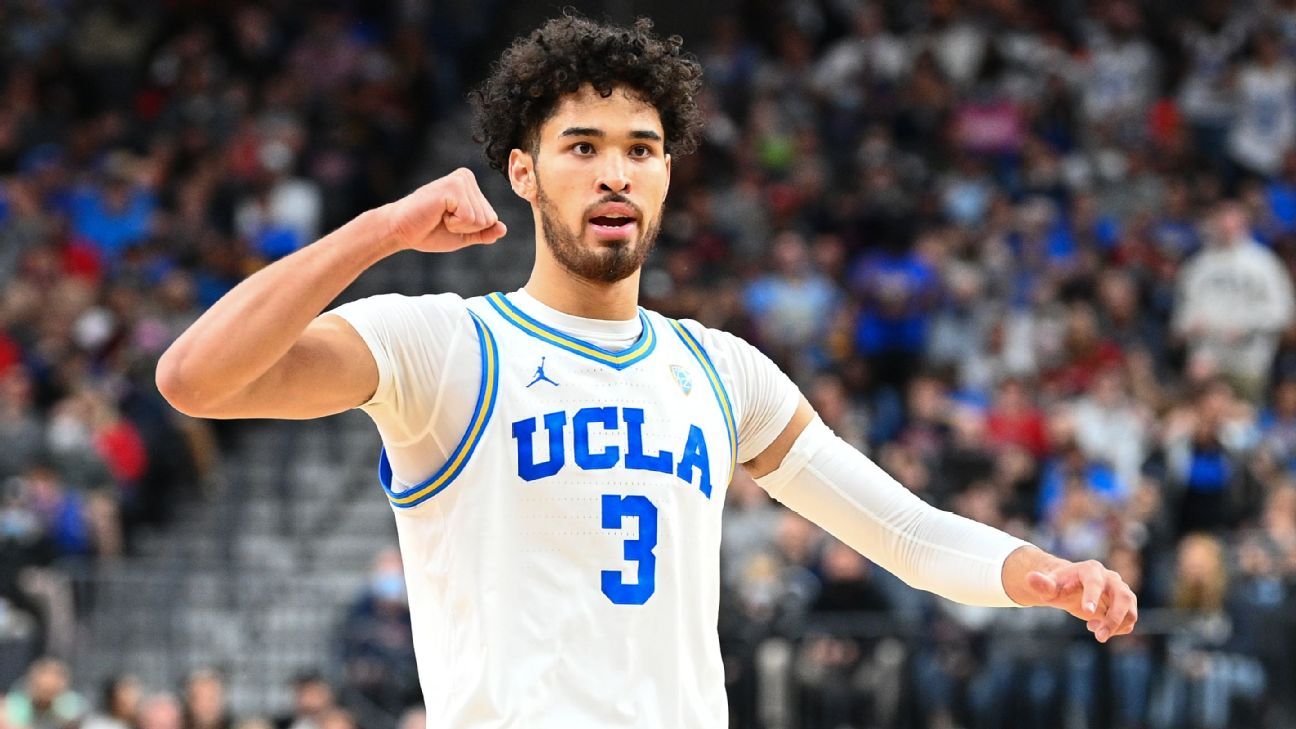Welcome back to our continuing look at one key question in this transfer-obsessed era: Just how important have transfers been — whether due to addition or subtraction — to each program in Division I’s top seven conferences?
Last week, we considered the Big 12. Before that, it was the Big 12 and Big East. Today we turn our attention to the Pac-12.
Note that we define a “transfer in” as someone who actually played minutes previously at a different four-year program. Conversely, a “transfer out” is simply a player who saw time at the Pac-12 program in question.
That’s all straightforward enough, right? Here are the most significant Pac-12 transfers of the modern era.

Best transfer in: Ryan Anderson, 2015-16
Anderson might seem like an upset pick here over T.J. McConnell and, more recently, James Akinjo. Then again, Anderson, a former Boston College star, had one of the better offensive seasons any Arizona player has recorded when he was the Wildcats’ leading scorer in 2015-16. Like McConnell and Akinjo, Anderson was named first-team All-Pac 12. He just happened to do all of the above during a relatively so-so year by Arizona standards, one in which the Wildcats went 25-9 and earned a No. 6 seed.
Most significant transfer out: James Akinjo, 2020-21
Akinjo has now achieved a rare distinction in this recurring series on transfers, having already been tapped as Georgetown’s most significant player to exit the program. He also holds that title with regard to Arizona. After two seasons with the Hoyas and then one with the Wildcats, Akinjo moved on to Baylor and averaged 13 points for a team that earned a No. 1 seed in the 2022 tournament.

Best transfer in: Shannon Evans, 2016-18
Evans followed the example set by his head coach Bobby Hurley and arrived at Arizona State after a two-year stint at Buffalo. In 2018, Evans started all 32 games and drained 95 3-pointers as the Sun Devils reached the NCAA tournament for the first time in four years.
Most significant transfer out: Remy Martin, 2017-21
Martin was named the preseason Big 12 player of the year for 2021-22 after he transferred from Arizona State to Kansas. His season as a Jayhawk can thus fairly be termed a success from start to finish, one that ended in a national title. In this same category of onetime Sun Devils, note that current UNLV head coach Kevin Kruger had a fine senior year as a player with the Runnin’ Rebels in 2006-07 after three strong seasons at ASU.

Best transfer in: Marcus Lee, 2017-18
Lee averaged 11 minutes for the great 38-1 Kentucky team in 2014-15. The Antioch, California, product subsequently elected to return to his home turf for his senior season. Lee started 31 games and averaged 11 points for the Golden Bears in 2017-18.
Most significant transfer out: Jordan Mathews, 2013-16
Mathews gets the nod here in a notably strong field of former Bears that includes Matt Bradley (who transferred from Cal to San Diego State), Charlie Moore (Kansas, DePaul and Miami) and Justice Sueing (Ohio State), to name but a few. At Gonzaga in 2016-17, Mathews started every game, up to and including the Bulldogs’ 71-65 loss to North Carolina in the national title contest.

Best transfer in: Carlon Brown, 2011-12
Brown averaged 12 points for CU in 2011-12, a relatively modest number that nevertheless earned him leading-scorer honors in head coach Tad Boyle’s second season. After playing three years for Utah and emerging as the Utes’ featured scorer as a junior, Brown transferred to Colorado for his senior season.
Most significant transfer out: Xavier Silas, 2006-08
Silas was originally recruited to CU by Ricardo Patton. He played his sophomore season for new head coach Jeff Bzdelik and then elected to follow Patton to Northern Illinois. Silas averaged 21 points over the course of two seasons for the Huskies.

Best transfer in: Joseph Young, 2013-15
Young wins what can only be termed a ferocious competition among incoming Oregon transfers, including Jacob Young (who arrived at UO by way of Rutgers), De’Vion Harmon (Oklahoma), Quincy Guerrier (Syracuse), Eugene Omoruyi (Rutgers), Eric Williams Jr. (Duquesne), Elijah Brown (Butler and New Mexico), Dylan Ennis (Villanova), Mike Moser (UNLV) and Jason Calliste (Detroit). After making 46 starts over the course of two seasons at pre-Kelvin Sampson Houston, Joseph Young capped off his career with a 30-point performance in Oregon’s 72-65 loss to No. 1 seed Wisconsin in the 2015 round of 32.
Most significant transfer out: Damyean Dotson, 2012-14
Dotson was a starter from the beginning of his first season at Oregon yet still elected to transfer to Houston for his junior and senior years. In 2016-17, he averaged 3.4 made 3s per game on 44% shooting and earned first-team All-AAC honors as the Cougars compiled a 22-11 record and received a No. 2 seed in the 2017 NIT.

Best transfer in: Warith Alatishe, 2020-22
Alatishe distinguished himself as one of the Pac-12’s top rebounders at both ends of the floor, as Oregon State not only won an automatic bid as the league tournament’s No. 5 seed but then made it all the way to the Elite Eight. His excellent work on the boards was already evident when Alatishe was a sophomore at Nicholls State.
Most significant transfer out: JaQuori McLaughlin, 2016-18
McLaughlin announced his intention to transfer out of the Oregon State program six games into his second season. He landed at UC Santa Barbara, and in 2020-21 he was named Big West player of the year. As a senior he averaged 16 points and five assists for the Gauchos while draining 40% of his attempts from beyond the arc.

Best transfer in: Drew Shiller, 2007-10
Shiller averaged 16 minutes coming off the bench for an 11-17 San Francisco team in 2005-06. Then Stanford beckoned from across the Bay, and with the Cardinal, Shiller redefined the term “3-point specialist.” As a senior in 2009-10, he shot 31% on just 51 2-point attempts while converting 39% of his 149 3-point tries. If the name “Shiller” doesn’t stand out in your memory, note that, rather incredibly, the last transfer to earn regular minutes for the Cardinal was onetime Santa Clara player Andrew Zimmermann in 2011-12. Stanford prefers to develop its own talent.
Most significant transfer out: Reid Travis, 2014-18
Travis was a two-time All-Pac 12 first-team selection before playing his final season at Kentucky. In 2018-19, Travis made 57% of his 2s and averaged seven rebounds for a Wildcats team that earned a No. 2 seed and reached overtime in the Elite Eight before falling to Auburn.

Best transfer in: Johnny Juzang, 2020-22
Juzang recorded one of the best individual tournament runs in recent memory in 2021 when UCLA played its way from the First Four all the way to overtime against overall No. 1 seed Gonzaga in the Final Four. In six tournament games the former Kentucky reserve scored 137 points and capped his efforts with a brilliant 29-point performance on 12-of-18 shooting against the Bulldogs.
Most significant transfer out: Joshua Smith, 2010-12
Smith never averaged more than 22 minutes in a four-year career that took him from UCLA to Georgetown. On a per-40-minute basis, however, Smith was consistently a difference-maker in scoring and rebounding, particularly on the offensive glass.

Best transfer in: Tahj Eaddy, 2020-21
Eaddy began his career at Southeast Missouri State and then played two seasons at Santa Clara before wrapping up his playing days with the Trojans in 2020-21. A listed weight of 165 pounds didn’t prevent Eaddy from making half his 2s (or 39% of his 3s) for the first USC team to reach an Elite Eight in 20 years.
Most significant transfer out: Byron Wesley, 2011-14
Wesley wins this honor in a close call over Jordan Usher. When Gonzaga reached the 2015 Sweet 16 (the first of seven consecutive regional semifinals and counting for the Bulldogs), Wesley was Mark Few’s starter at wing. As for Usher, he saw sporadic minutes over two seasons at USC before starting 80 games for Georgia Tech over the past three years.

Best transfer in: David Collette, 2016-18
Collette’s minutes were limited by foul trouble, yet he still averaged 13 points over two seasons for the Utes. He achieved this level of production in the Pac-12 after making a splash in the Mountain West during the first season of his career at Utah State. Note that Delon Wright transferred to Utah in 2013 from City College of San Francisco and thus doesn’t fit the “four-year school to four-year school” definition of transfer used here.
Most significant transfer out: Timmy Allen, 2018-21
Allen was a standout on a 2020-21 Utah team that also included such notable outbound transfers as Alfonso Plummer (Illinois) and Pelle Larsson (Arizona). In three seasons with the Utes, Allen rang up over 1,300 points and grabbed more than 500 rebounds. That was enough to catch the eye of one Chris Beard, who then brought Allen to Texas.

Best transfer in: Jamaal Williams, 2004-06
Williams was the second-leading scorer behind Brandon Roy on the Huskies team that reached the 2006 Sweet 16 before falling in overtime to No. 1 seed UConn. Prior to his star turn at Washington, Williams scored more than 500 points over the course of two seasons playing first for Fran Fraschilla and then for Ritchie McKay at New Mexico.
Most significant transfer out: Nigel Williams-Goss, 2013-15
Williams-Goss teamed with Jordan Mathews (see Cal, above), among others, on the Gonzaga team that lost to North Carolina in the 2017 national title game. Before he was a Zag, Williams-Goss in 2013-14 was the latest in an impressive string of highly ranked recruits signed by Lorenzo Romar at Washington. Elston Turner, who excelled at Texas A&M from 2011 to 2013, was another Romar signee who went on to big things at a different program.

Best transfer in: Taylor Rochestie, 2006-09
Rochestie was a fixture on Tony Bennett’s Washington State teams that also featured Klay Thompson and Aron Baynes. When the Cougars reached the 2008 Sweet 16, Rochestie averaged 10 points and shot 43% on his 3s. That tournament run by WSU marked a remarkable turn of fortune for a player who started his career on a 10-18 Tulane team in 2004-05.
Most significant transfer out: Malachi Flynn, 2016-18
Flynn won both player of the year and defensive player of the year honors in the Mountain West after leading San Diego State to a 30-2 record in the pandemic-shortened 2019-20 season. His success in one season at SDSU came after two productive years as a starter at Washington State. Flynn followed the same Cougars-to-Aztecs sequence charted by Xavier Thames almost a decade earlier.
